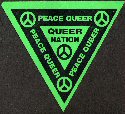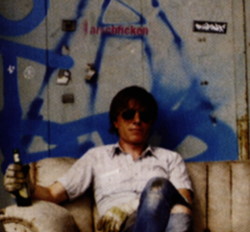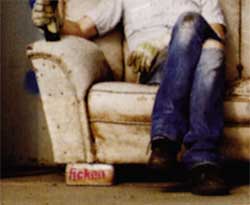version 0.1 (abstract) | 25/05/2006
version 0.2 (script) | 07/08/2006
"Queer" phaenomena
A critical discussion about current uses of "queer" as an urban image factor, as a label for homonormative ambitions and as a cultural modifier
Intro:
With our contribution we want to introduce three phaenomenas of the current queer discourse. Each of these phaenomenas stand for a specific perception (and use) of queer issues. It is our aim to discuss these tendencies and to reflect on their impact on queer politics and practice. Today there are big differences on what is meant with »queer«, between theory and common life, between personal practice and communities sense, between different cultural, social and ethnic contexts. While for some »queer« is a funky term of a new form of cultural expression, for other it is understand as a term for political empowerment, while in some places the CSD parades are more or less shortened as commercial festivals, on other places the marches for equality and tolerance are threatened by prejudice, active intolerance and even violence. But what are the common goals and aims of our queer politics? What are the perspectives beyond the differences? We think that there is a need for a open and broad discussion about this, and we would like to give one input on this discussion.
(Short introduction of ourselves)
As examples of the current use of "queer" we want you to introduce three aspects in this context, afterwards we take a look on possible questions (and answers), that we would like to discuss with you.
Queer as an urban image factor
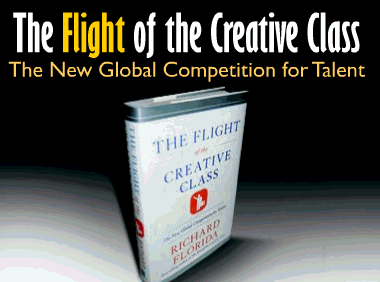
A vivid urban queer scence can be understand as a positive factor for urban developement and marketing. An american scientist, Richard Florida, created a so-called »Creativity Index«, where a "gay index" is one decicive factor. In this logic only cities with a tolerant climate for non-straight communities can reach a good »Creativity Index« ranking. Beside culture, art, creativity, tourism, nightlife and lifestyle the images of gay cultures are used for a tolerant and open-minded image of the city. The yearly gay pride parades became an obvious part in the calendars of events of the cities. In this sense queer cultures contribute to an ideal of diversity for the creative city. But how affects the transformation and re-definition of the city into a corporate city onto the gay community respectively the queer life in the city? The discovery of queer life as a location factor promises more importance and perception and within the chance to take part in public and social life, but there's to question and reflect which parts of queer life are appreciated and which are further marginalized and put under a taboo.
additions & sources: /UrbanImageFactor?
Queer as a label for homonormativity
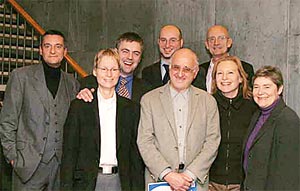 the "initiative queer nations", founders and members of the board of trustees
the "initiative queer nations", founders and members of the board of trustees
German mainstream gay and lesbian representatives are currently in train to establish a »Queer Nations« institute. The name of this institute has a strange double meaning -- Queer, which stands for more, than just for a gay and lesbian sexual orientation-- and Nations, the construction of a spatial and political entity [...]
There has been other uses of the term "queer nation" before, a short comparision might be useful to understand the latest use.
The transformation of a term and its visualisation:
The political initiative queer nations in US, early 90s (a follow up of act up campaigns, organized in chapters in major US-cities, used direct and media action in public space to fight against homophobia and hatespeech). (...) "they ultimately collapsed under the weight of their contradictions: 'queer', after all, means 'diversity', whereas 'nation' implies 'sameness'" (Susan Stryker)
- logo comes as trashy, 80s DIY-mashup with "alternative" symbolism (peace sign!)
the queer nation party series at london in the 2000s
- logo of london party logo works with a subcultural, subversive punkrock typographic style
and the queer nations initiative in germany in 2006
- an ad agency way of making a logo, unintrusive colors, very neutral on impact and meaning, could be used for arbitrary uses
What are concept and intentions of the initiative "queer nations"?
The initiative claims to build a central institution of research of homosexuality. Quote: "The aim of the association is to further study and research into the history and the sociology of homosexuality, along with public awareness for subject, in order to advance the equality of people of differing sexual orientations." (charter of the initiative)
Critics, like in an open-letter by the lesbian-feminist-queer academic network, say, that they reject a concept, which is based "on patriotic-nationalistic signs" and fixed on a "assimilative perspective of normalization and integration"
After the area of »Gay liberation« in the 70s, the fight against »ignorance and fear« during the upcoming of the AIDS pandemia in the 80s, and the gay marriage campaigns during the 90s, gay and lesbian mainstream activists lack of further perspectives. While homo- and other sexual derived phobia, hatespeach and hatecrimes are not vanished in german society today, media and the mainstream discourse has accepted certain forms of gay and lesbian cultural presence. The protagonists of this presence endeavor to fortify their positions (external as accepted and tolerated parts of the society, internal as opinion leader), while they adfirm common (mis-)interpretation of non-heterosexualities and while they exclude different concepts and understandings of non-straight.
- remark: "playing" good conduct as a strategy: monogamic, working and successfull, neutral on all aspects of politics execpt the own identity politics, neutral on sexual aspects
According to this, the initiative "Queer Nations" seems to be another effort to normalize and establish gay and lesbian culture in the "heart" of german society. It is, so to say, a project "to freeze social identities and to eliminate the claims of equality" (brian holmes).
We have to ask further questions: What are the intentions behind these efforts of normalization, of "homonormativitiy" (L. Duggan), and what consequences on the meaning of queer, the rights and awareness of other arouse from this? Are resarches of history and sociology, are such "politics of identity and assimilation", as critics say (E. Stedefeldt), the final word of gay liberation? What could be different, open and further tracks of development, not based on consensus but on dissent.
additions & sources: /LabelForHomonormativity
Queer as a subcultural modifier
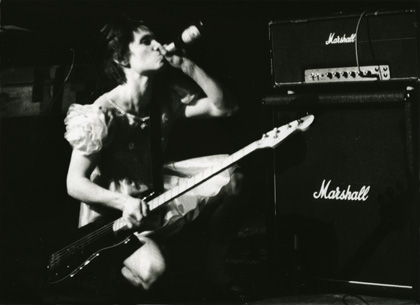
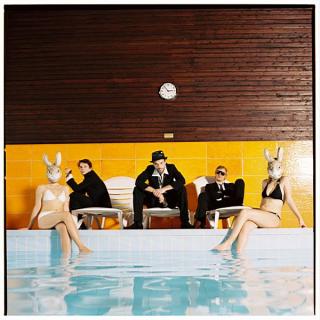 one band, switching between two different cultural codes: crossdressing in 2005, playboy style in 2006
one band, switching between two different cultural codes: crossdressing in 2005, playboy style in 2006
Queer (sub)cultural expressions carry a funky lifestyle, that is increasingly established in music, arts, films and other fields of cultural production. The need is, to ask, if there is (still) any progressive potential of 'the other' in subculture.
The complexity of self-identification and appearance is being reduced by blending into cultural produced images. Under this assumption, what does it mean to blend into the image of being 'subcultural' and 'queer'? Are those representations political, do they have social implications? Can such representations stir irritation by empowering alternative meanings that go beyond heteronormativity? In some images, a kind of integrated dysfunction or shift has already been achieved by slightly mismatched styling. Up to now, addressing otherness, as well as highlighting that heteronormativity is not natural, were applied as suitable strategies for antinormalisation. Yet today, in times where images and codes, which were stigmatised earlier, become rapidly part of the mainstream, we face the question whether queer subcultural representation is still influential. In other words, can visible queerness still challenge the project of neoliberal normalisation, when visibility does no longer equal political impact? In queer discussions, answers that are offered, include the strategies of 'disidentification' (José Esteban Muñoz) and of 'turning invisible' (Beatrice Preciado). Also, it has been demanded to abandon the label 'queer' all together. The current situation is characterised by old and new repression as well as by being embraced by neoliberal integrational attempts. So, which positions propose options for powerful political acting?
additions & sources: /SubculturalModifier
/Questions
copy and paste questions here
As mentioned beforehand, we see a need for a common and critical discussion about current phaenomenas. To approach this issue, our contribution will be part of a two-track tour through Poland and Germany, scheduled for august and september this year. The first track will come with the issues described here. Our next lecture will be Poznan on friday. The second track will be held in two stations in Germany, in Bremen and Hannover at the beginning of october. This second track will be used to illustrate and discuss the current situation and issues of LGBTQ's in Poland. Both tracks are thus two different efforts to find a common approach on this discussion. They are organized by an informal network of LGBTQ activists from poland and germany.
Persons
Our Panel will be prepared and held by:
Thomas Böker, Bremen, cultural activist, co-organizer of the cultural center »zakk«, member of »kraß« (a queer project) and »city.crime.control« (group working on urban issues, city developement and public space)
Ulf Treger, Hamburg, cultural producer, member of the projects »city.crime.control« and »offene kartierung« (working an mapping and perception of urban space), volunteer and co-founder of »q-tipp« (a local plattform on queer culture at hamburg)
Christiane Wehr, Hamburg, artist, queer filmer, student of philisophy and queer studies at the university of Hamburg, member of »offene kartierung«
